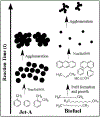Impact of Biofuel Blends on Black Carbon Emissions from a Gas Turbine Engine
- PMID: 32327881
- PMCID: PMC7180060
- DOI: 10.1021/acs.energyfuels.0c00094
Impact of Biofuel Blends on Black Carbon Emissions from a Gas Turbine Engine
Abstract
Presented here is an overview of non-volatile particulate matter (nvPM) emissions, i.e. "soot" as assessed by TEM analyses of samples collected after the exhaust of a J-85 turbojet fueled with Jet-A as well as with blends of Jet-A and Camelina biofuel. A unifying explanation is provided to illustrate the combustion dynamics of biofuel and Jet-A fuel. The variation of primary particle size, aggregate size and nanostructure are analyzed as a function of biofuel blend across a range of engine thrust levels. The postulate is based on where fuels start along the soot formation pathway. Increasing biofuel content lowers aromatic concentration while placing increasing dependence upon fuel pyrolysis reactions to form the requisite concentration of aromatics for particle inception and growth. The required "kinetic" time for pyrolysis reactions to produce benzene and multi-ring PAHs allows increased fuel-air mixing by turbulence, diluting the fuel-rich soot-forming regions, effectively lowering their equivalence ratio. With a lower precursor concentration, particle inception is slowed, the resulting concentration of primary particles is lowered and smaller aggregates were measured. The lower equivalence ratio also results in smaller primary particles because of the lower concentration of growth species.
Figures








References
-
- Xue X; Hui X; Singh P; Sung C-J Soot formation in non-premixed counterflow flames of conventional and alternative jet fuels. Fuel 2017, 210, 343–351.
-
- Zhang C; Hui X; Lin Y; Sung C-J Recent development in studies of alternative jet fuel combustion: Progress, challenges, and opportunities. Renew. Sustain. Energy Rev 2016, 54, 120–138.
-
- Abrahamson JP; Zelina J; Andac MG; Vander Wal RL Predictive model development for aviation black carbon mass emissions from alternative and conventional fuels at ground and cruise. Environ. Sci. Technol 2016, 50, 12048–12055. - PubMed
-
- Austin G; Naber J; Johnson J; Hutton C Effects of biodiesel blends on particulate matter oxidation in a catalyzed particulate filter during active regeneration. SAE Int. J. Fuels and Lub 2010, 3, 194–218.
Grants and funding
LinkOut - more resources
Full Text Sources
